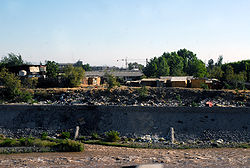Campamento (Chile)

Campamento ("camp", or "tent city") and población callampa ("mushroom town") are terms given in Chile to shanty towns. The term "mushroom town" refers to the speed in which these informal settlements sprung up between the 1960s and the 1980s, literally overnight. Nowadays, the term campamento has replaced "mushroom town".
Definition[]

According to the NGO Un Techo para Chile ("A roof for Chile"), a campamento is defined as a group of crude dwellings of more than eight families, lacking at least one of the following basic services: drinking water, electricity and wastewater treatment, and which are illegally residing on the land.[1]
Population[]
As of 2004, there were 531 campamentos in Chile. A total of 27,785 houses were home to 32,371 families in these shanty towns. It was estimated that 75% of that population was living below the national poverty line and 41% living under extreme poverty.[1] According to figures released by the Ministry of Housing and Urban Development (MINVU), in 2011, there were 657 campamentos, in which 27,378 families lived and in 2018, there were 822 campamentos, where 46,423 families live.[2]
Between 2010 and 2020, the total number of campamentos grew by 22%. The highest increases were seen in the cities of Antofagasta, Calama, Copiapó, Iquique-Alto Hospicio, La Serena, Valparaíso and Viña del Mar.[3]
See also[]
References[]
- ^ a b El Mercado Laboral en Campamentos Archived 2012-03-11 at the Wayback Machine, CIS, Un Techo Para Chile. Department of Economy, University of Chile. December 2004.
- ^ Arafat, Mohammed (20 February 2019). "Chile's Campamentos - An Invisible Tragedy". Chile Today. Retrieved 8 October 2020.
- ^ Boano, Camillo; Perucich, Francisco Vergara (11 May 2020). "Chile: Protect the campamentos! | UCL The Bartlett Development Planning Unit". UCL. Retrieved 8 October 2020.
- Chilean society
- Populated places in Chile
- Human habitats
- Shanty towns in South America
- Slums in South America
- Buildings and structures in Santiago
- Types of administrative division
- Geography of Santiago, Chile
- Squatting